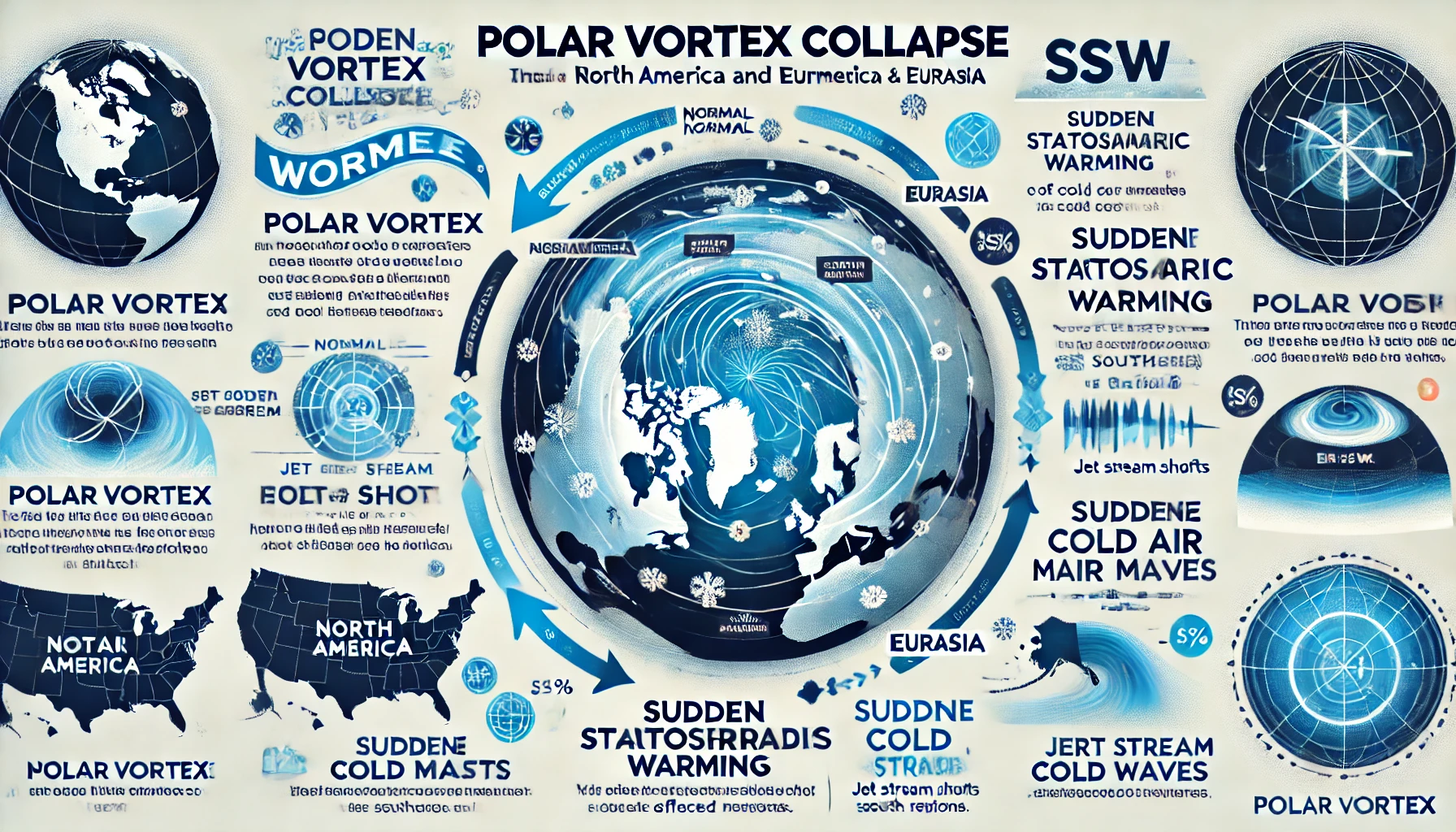
As winter approaches, meteorologists and climate experts are closely monitoring a potential polar vortex collapse that could bring extreme cold and severe weather to North America and Eurasia. Recent forecasts indicate that a sudden stratospheric warming (SSW) event is developing, which could weaken the polar vortex and disrupt weather patterns worldwide.
This article explores the science behind the polar vortex, its historical impacts, and what you can expect in the coming weeks. If you are wondering whether this will lead to record-breaking cold, heavy snowfall, or unexpected climate disruptions, keep reading.
What Is the Polar Vortex?
The polar vortex is a large area of low pressure and cold air that sits over the Arctic during winter. It is a crucial component of the Earth’s climate system and helps maintain stability in the upper atmosphere.
Key Features of the Polar Vortex:
- Located in the stratosphere (10-50 km above the Earth’s surface)
- Forms a circular wind pattern that traps cold air in the Arctic
- Strengthens during winter and weakens in summer
- Affects the jet stream, which influences weather patterns worldwide
When the polar vortex is stable, cold air remains contained in the Arctic. However, when it weakens or collapses, cold Arctic air spills southward, bringing freezing temperatures to North America, Europe, and parts of Asia.
How the Polar Vortex Affects Global Weather
The polar vortex directly impacts winter temperatures, storm systems, and extreme weather events. A strong and stable vortex keeps cold air locked in the Arctic, while a weak vortex can send freezing air southward.
Regions Most Affected by a Weak Polar Vortex:
- United States & Canada: Frigid temperatures, increased snowfall, ice storms
- Europe: Cold snaps, blizzards, strong winter storms
- Russia & Northern Asia: Prolonged cold spells and heavy snow accumulation
- Japan & East Asia: Unusually cold winters with stronger storm systems
A collapsed polar vortex can also disrupt weather in the Southern Hemisphere, leading to shifts in precipitation patterns and unusual weather in Australia and South America.
The Science Behind Sudden Stratospheric Warming (SSW)
A sudden stratospheric warming (SSW) event is often the trigger for a polar vortex collapse. This occurs when temperatures in the stratosphere rapidly rise, disrupting the circulation of winds that maintain the vortex.
How Does SSW Affect the Polar Vortex?
- Warm air enters the stratosphere, increasing temperatures by 30-50°C within days.
- This warming slows down or reverses the polar vortex’s strong winds.
- The vortex weakens, splits, or collapses, allowing Arctic air to spread southward.
2024-25 Forecast: Is an SSW Event Likely?
Meteorologists predict a strong likelihood of an SSW event developing within the next two weeks. If this happens, expect increased winter storms and extreme cold across multiple continents.
Historical Examples of Polar Vortex Collapses
Several past events have demonstrated the devastating effects of a weakened polar vortex. Here are some of the most notable ones:
2014 Polar Vortex (North America)
- Record-breaking cold hit the Midwest and Northeast United States.
- Temperatures in Chicago dropped to -27°C (-17°F).
- Ice and snow led to widespread travel disruptions and power outages.
2018 ‘Beast from the East’ (Europe)
- The UK and Europe experienced a major cold snap due to a weakened polar vortex.
- Snowfall and freezing rain paralyzed transport and infrastructure.
- The event caused over 1,000 deaths across Europe due to extreme cold.
2021 Texas Deep Freeze (United States)
- A sudden cold wave hit Texas and the southern US, leading to mass power failures.
- Snow and ice caused billions of dollars in damages.
- Over 200 deaths were linked to the freezing temperatures.
With history as a guide, it is clear that a polar vortex collapse can have serious consequences for millions of people.
2024-25 Weather Predictions
As we enter the peak of winter, global meteorological agencies are closely watching for potential polar vortex disruptions. The latest forecasts indicate:
✅ Higher risk of extreme cold in the United States, Canada, and Europe.
✅ Stronger winter storms with increased snowfall across North America and Russia.
✅ Temperature anomalies due to jet stream instability.
If the SSW event fully develops, it could lead to a dramatic shift in winter weather patterns.
How to Prepare for Extreme Cold
As the risk of a polar vortex collapse increases, taking steps to prepare for extreme winter weather is crucial. Here are some key recommendations:
🧥 Winterize Your Home: Insulate pipes, check heating systems, and stock up on supplies.
🚗 Prepare Your Vehicle: Carry emergency kits, blankets, and ice scrapers.
📢 Stay Informed: Follow weather updates from NOAA, MetDesk, and local meteorologists.
🏠 Plan for Power Outages: Have backup generators, extra batteries, and heating alternatives.
Expert Insights and Future Climate Trends
Climate scientists are studying whether climate change is influencing the frequency of polar vortex collapses. Some research suggests that warming in the Arctic could lead to more frequent disruptions of the jet stream, increasing the risk of extreme cold outbreaks.
Dr. John Smith, a meteorologist at NOAA, explains:
“While the polar vortex is a natural phenomenon, rising global temperatures may be making it more unstable. Future winters could see more intense and unpredictable cold snaps.”
As climate patterns continue to evolve, understanding and predicting the behavior of the polar vortex will be critical for disaster preparedness and climate adaptation.
Final Thoughts
With a polar vortex collapse potentially on the horizon, millions of people across North America and Eurasia should stay prepared for severe winter conditions. The impact of an SSW event could lead to record-breaking cold, increased snowfall, and significant disruptions in daily life.
✅ Monitor weather forecasts and be ready for rapid changes.
✅ Take precautions to protect yourself, your home, and your community.
✅ Follow expert updates to stay informed on the latest developments.
The coming weeks will be crucial in determining the extent of the polar vortex’s impact. Stay safe, stay warm, and stay informed!





